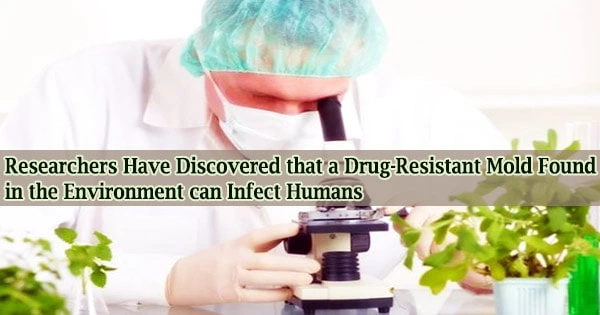According to a recent study done by Imperial College London, drug-resistant mold is spreading from the environment and infecting the lungs of those who are susceptible.
The researchers discovered six cases of persons afflicted with a drug-resistant strain of the fungus Aspergillus fumigatus, which they linked to spores in the environment. Their findings, which were published in Nature Microbiology, were based on samples from England, Wales, Scotland, and Ireland.
Aspergillus fumigatus is a fungal lung disease-causing mold found in the environment. People with healthy lungs can clear inhaled spores, but those with lung diseases or weakened immune systems may not be able to, resulting in the spores remaining in the lungs and producing aspergillosis.
Aspergillosis is a fungal infection that affects 10-20 million individuals globally. Antifungal medicines are commonly used to treat the illness, however growing resistance to these drugs has been noted.
According to the experts, this resistance has arisen as a result of the widespread use of azole fungicides in agriculture. Azole medications that function in a similar way are the first-line treatment for individuals afflicted with the Aspergillus fumigatus mold, thus the fungus’ exposure to azole fungicides in the environment implies it is often drug-resistant even before it infects people.
The researchers recommend that Aspergillus fumigatus be monitored more closely in the environment and in clinics to better understand the risk it poses.
Senior author, Professor Matthew Fisher, from Imperial’s School of Public Health, says: “Understanding the environmental hotspots and genetic basis of evolving fungal drug resistance needs urgent attention because resistance is compromising our ability to prevent and treat this disease.”
He adds: “The prevalence of drug-resistant aspergillosis has grown from negligible levels before 1999 to up to 3-40% of cases now across Europe. At the same time, more and more people might be susceptible to Aspergillus fumigatus infection because of growing numbers of people receiving stem cell or solid organ transplants, being on immunosuppressive therapy, or having lung conditions or severe viral respiratory infections.”
Increasingly, the cases of aspergillosis seen in the clinic are resistant to first-line azole drugs. However, we’ve not been sure how patients are acquiring these infections whether they develop in the lungs during treatment for the infection, or whether the mould spores that infect them are drug-resistant in the first place. Our study finds that both routes of infection are possible and confirms concerns that pre-resistant mould spores in the environment are able to enter and infect people’s lungs causing harder-to-treat disease.
Dr. Johanna Rhodes
Between 2005 and 2017, the researchers isolated 218 Aspergillus fumigatus samples from England, Wales, Scotland, and Ireland for the study. Around seven out of ten samples were from infected persons (153 from 143 patients in five hospitals) and the rest came from the environment (65 samples), including soil, compost, plant bulbs, the air, and other sources.
The researchers sequenced the DNA recovered from the sample molds to see if there was any crossover between the resistant spores found in the environment and in some patients.
They discovered six Aspergillus fumigatus strains in the environment that had infected six people. The genetic similarities, according to the researchers, suggested that the fungus had transferred from the environment to the patient.
Lead author, Dr. Johanna Rhodes, from Imperial’s MRC Centre for Global Disease Analysis within the School of Public Health, says: “Increasingly, the cases of aspergillosis seen in the clinic are resistant to first-line azole drugs. However, we’ve not been sure how patients are acquiring these infections whether they develop in the lungs during treatment for the infection, or whether the mould spores that infect them are drug-resistant in the first place. Our study finds that both routes of infection are possible and confirms concerns that pre-resistant mould spores in the environment are able to enter and infect people’s lungs causing harder-to-treat disease.”
Almost half of the 218 samples (106 samples) were resistant to at least one of the clinic’s first-line azole medications. Itraconazole resistance was found in 48 percent (104 samples), voriconazole resistance in 29 percent (64 samples), and posaconazole resistance in 21 percent.
More than 10% of the samples (26 in total, 23 from the environment, and 3 from patients) were resistant to two or more azole medications. The researchers discovered 50 novel genes linked to medication resistance among the 218 samples.
They also discovered five new combinations of single-digit alterations in the DNA (called single nucleotide polymorphisms, or SNPs) that were linked to medication resistance, including one that was resistant to multiple treatments, after digging further into the DNA.
The researchers discovered two unique groups of Aspergillus fumigatus samples when they looked at the genes: group A (123 of the 218 samples) and group B (95 samples).
Around 80% of samples in group A were resistant to drugs, but only roughly 85% of samples in group B were. While the two groups were separate, the researchers discovered evidence of genetic material swapping and, in some cases, the creation of new drug resistance variants.
These data, according to the researchers, imply that the complete spectrum of azole resistance in Aspergillus fumigatus is still unknown.
Dr. Rhodes says: “Our findings highlight new ways of resistant infections passing to people and show that a better understanding of where and how Aspergillus fumigatus is generating drug resistance is needed.”
The Natural Environment Research Council, the Wellcome Trust, Gilead Sciences, and the Medical Research Council all contributed to the research. It involved researchers from Imperial, King’s College University Hospital, Trinity College Dublin, University of Aberdeen, The University of Manchester, Public Health Wales, Lee Kong Chian School of Medicine, Nanyang Technological University, Beaumont Hospital, Tallaght University Hospital, University of Nottingham, the National Mycology Reference Laboratory at the UK Health Security Agency, University of Exeter, and Leeds Teaching Hospitals National Health Service Trust.





